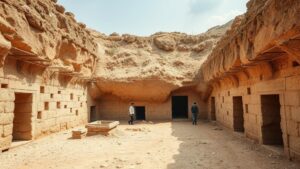Exploring the “Temple of Shattered Stars,” ruins in South America said to align with a meteor strike.
Exploring the Temple of Shattered Stars
The Temple of Shattered Stars, a fascinating archaeological site located in the dense jungles of Peru, is believed to align with the impact of a meteor strike thousands of years ago. This ancient ruin, with its intricate structures and celestial significance, has captured the attention of researchers and adventurers alike. In this article, we will explore the sites history, the scientific theories surrounding its alignment with a meteor, and its implications for our understanding of ancient civilizations in South America.
Historical Background
The Temple of Shattered Stars is thought to have been constructed by the ancient cultures of South America, particularly the Inca civilization, around 1300 CE. precise location of the site is in the Madre de Dios region of Peru, an area that has seen scarce exploration owing to its remote and dense rainforest environment.
Archaeologists discovered the ruins in 2003, finding remnants of ceremonial platforms, unusual rock formations, and structures that display advanced astronomical alignments. Historical records suggest that this area was frequented by shamans and astronomers who revered the skies and made predictions based on celestial events.
Scientific Investigations
Recent studies have led researchers to theorize that the temple was deliberately constructed to commemorate an ancient meteor strike. Geologists have examined the surrounding area and identified microtektites–glassy spheres formed by meteorite impacts–within the soil composition. e findings provide compelling evidence suggesting a catastrophic event may have occurred around 1000 CE, long before the sites construction.
Plus, the alignment of the temples main structure with celestial bodies supports the idea that the ancient builders had a sophisticated understanding of astronomy. According to a study published in the journal Ancient Astronomy in 2021, the site aligns with the trajectory of the meteor, reinforcing the notion that it was built as a form of tribute or protective charm against such cosmic events.
Architectural Features
The architectural design of the Temple of Shattered Stars showcases the advanced engineering skills of its creators. Key features include:
- Stone Carvings: Intricate carvings depicting celestial symbols and local fauna can be found throughout the site.
- Ceremonial Platforms: Raised structures presumed to be used for spiritual ceremonies, facing towards the night sky.
- Astronomical Observatories: Alignments that suggest markings for solstices and other significant celestial events.
These features not only emphasize the temples importance but also reflect the deep connections ancient cultures had with astronomy and mythology.
Ecological and Cultural Significance
The Temple of Shattered Stars is situated in a biodiverse region of Peru, making its preservation essential for both ecological and cultural reasons. site has become a focal point for conservation efforts, as it harbors unique flora and fauna that are endangered due to habitat loss. Efforts are underway to establish the area as a protected site, promoting sustainable tourism while respecting its cultural heritage.
Also, the temple serves as a potent reminder of the regions ancient civilizations. It poses important questions about how these cultures understood and interacted with their environment. Understanding this relationship can offer insights into contemporary issues, such as climate change and biodiversity loss.
Visiting the Ruins
For those wishing to experience the Temple of Shattered Stars, guided tours are available through various eco-tourism companies based in Cusco. These tours not only facilitate access to the site but also support local communities economically, providing an incentive to preserve both the ruins and their surrounding ecosystems.
Typical tours include:
- Hiking Expeditions: Trekking through the diverse landscapes of the Amazon rainforest.
- Guided Educational Tours: Learning about the sites significance from archaeologists and local historians.
Conclusion
The Temple of Shattered Stars stands as a testament to the ingenuity and spiritual depth of ancient South American civilizations. Its alignment with a meteor strike not only deepens our understanding of the people who constructed it but also highlights their reverence for the cosmos. As ongoing research continues to unravel the mysteries of this site, it is clear that the Temple of Shattered Stars has much to teach us about the past and its relevance to our current understandings of humanitys connection to the universe.
For those interested in archaeology, astronomy, or eco-tourism, the Temple of Shattered Stars offers a unique chance to engage with both history and nature, emphasizing the incredible legacy of ancient cultures in South America.



